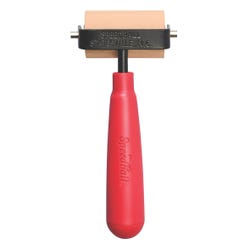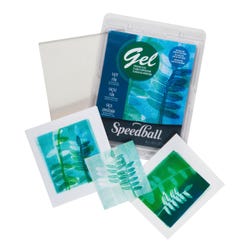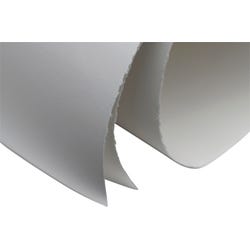Kandinsky Recycled

Description
Lesson Plan and Artwork by Mary Reilly
Using printing plates, inks and recycled materials, students will create a monoprint featuring different color planes and geometric shapes reminiscent of Wassily Kandinsky’s abstract paintings.
Objectives
- Students will study the works of Wassily Kandinsky paying special attention to geometric shapes and color planes.
- Students will learn how to make a monoprint using a printing plate.
- Students will create tools out of recycled materials to use with their monoprint plates to create abstract geometric images within their prints.
Supplies Needed
Inks, set of 8, 8 oz. jars
5x5 Gel Printing Plate
12x12 Gel Printing Plate
5x7 Gel Printing Plate
2 inch Soft Rubber Brayer
5x7 Gel Printing Plate
8x10 Gel Printing Plate
Paper 9x12
8x10 Gel Printing Plate
4 inch Soft Rubber Brayer
Printmaking Paper, 8.5x11, pack of 100
4 inch Soft Rubber Brayer
*Here are the supplies needed for this lesson plan for reference. Find a convenient carousel of shoppable products for this lesson below.
Standards
Standard #1: Generate and conceptualize artistic ideas and work.
Standard #3: Define and complete artistic work.
Standard #8: Interpret intent and meaning in artistic work.
Instructions
1
Explore with students the abstract art of Wassily Kandinsky. Discuss the geometric shapes used as well as how the artist used color planes to define shapes.
2
Have students collect various recycled materials like bubble wrap, plastic bottle caps, paper towel rolls, plastic mesh and corrugated board. Ask student to look for items that have geometric shapes as part of their design.- i.e. bottle caps are circular corrugated board has triangles within. Have students share their findings to make sure all items are safe.
3
Show students how they can create their own geometric shapes using cereal boxes cut into two inch strips. The strips can be shaped into concentric circles, triangles, rectangles and squares by bending and taping into place. Scrap mat board can be cut into strips to create linear effects within their designs. Students can use scrap pieces of mat board or railroad board and create paint scrapers of their own design.
4
Students can collect sponges, cotton swabs and old brushes to remove areas of ink from their gel printing plates.
5
The gel plates have a soft surface allowing the recycled materials to be used to create both geometric and linear patterns within their design. Recycled materials such as bubble wrap can create texture. Discuss and demonstrate these techniques with students.
6
If the inks being used are soy based and have a slower drying time- allow the plates to be inked and work on before printing. These inks clean up easily with the use of baby wipes. When printing is complete wash in warm soapy water. Store in clam shell to prevent damage during storage.
7
With inks the adage “less is best” applies. Set up inking stations for students using minimal amounts of ink. Using a soft rubber brayer, roll out ink and apply to plates. Demonstrate this process. Show how the recycled materials collected can be used to add geometric shapes and patterns to create an abstract print. Have time for students to experiment before completing their final print.
8
Display prints and have students explain the various tools and techniques they used.








